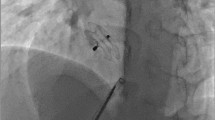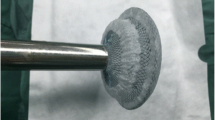Abstract
The Occlutech® Figulla® septal occluder (OFSO) is a later-generation double-disk device with few reports of its success rates and complications compared with the Amplatzer® septal occluder (ASO), which is the worldwide standard device in percutaneous atrial septal defect (ASD) closure. We recruited and compared the results in 149 patients (76.5 % female) who underwent ASD device closure in our center between January 2003 and June 2012. The patients ranged in age from 2.3 to 77.2 years. There were no statistically significant differences between the two groups regarding patient baseline characteristics and procedure variables. The success rate using either device was excellent (ASO 94.4 % and OFSO 97.4 %; p = 0.43). Although the diameter of the ASD and the pulmonary arterial pressure in the OFSO group were slightly higher than in the ASO group, the median fluoroscopic time in the OFSO group was significantly shorter (ASO 13.7 min; OFSO 9.0 min; p < 0.001). The overall median follow-up time was 3.6 years (interquartile range 2.1–9.0 years). There were no significant differences between the major and minor complications when comparing the two devices. Both devices were safe and effective for percutaneous ASD closures. The OFSO had the benefit of a shorter fluoroscopic time.




Similar content being viewed by others
References
Abaci A, Unlu S, Alsancak Y, Kaya U, Sezenoz B (2013) Short and long term complications of device closure of atrial septal defect and patent foramen ovale: meta-analysis of 28,142 patients from 203 studies. Catheter Cardiovasc Interv 82:1123–1138. doi:10.1002/ccd.24875
Amin Z, Hijazi ZM, Bass JL, Cheatham JP, Hellenbrand WE, Kleinman CS (2004) Erosion of Amplatzer septal occluder device after closure of secundum atrial septal defects: review of registry of complications and recommendations to minimize future risk. Catheter Cardiovasc Interv 63:496–502
Ammar RI, Hegazy RA (2013) Transcatheter closure of secundum ASD using Occlutech Figulla-N device in symptomatic children younger than 2 years of age. J Invasive Cardiol 25:76–79
Aytemir K, Oto A, Ozkutlu S, Kaya EB, Canpolat U, Yorgun H, Sahiner L, Kabakçi G (2012) Early-mid term follow-up results of percutaneous closure of the interatrial septal defects with occlutech figulla devices: a single center experience. J Interv Cardiol 25:375–381
Cansel M, Pekdemir H, Yağmur J, Tasolar H, Ermis N, Kurtoglu E, Acıkgoz N, Atas H, Ozdemir R (2011) Early single clinical experience with the new Figulla ASD occluder for transcatheter closure of atrial septal defect in adults. Arch Cardiovasc Dis 104:155–160
DiBardino DJ, McElhinney DB, Kaza AK, Mayer JE Jr (2009) Analysis of the US Food and Drug Administration Manufacturer and User Facility Device Experience database for adverse events involving Amplatzer septal occluder devices and comparison with the Society of Thoracic Surgery congenital cardiac surgery database. J Thorac Cardiovasc Surg 137:1334–1341. doi:10.1016/j.jtcvs.2009.02.032
Du ZD, Hijazi ZM, Kleinman CS, Silverman NH, Larntz K (2002) Comparison between transcatheter and surgical closure of secundum atrial septal defect in children and adults: results of a multicenter nonrandomized trial. J Am Coll Cardiol 39:1836–1844
Durongpisitkul K, Soongswang J, Laohaprasitiporn D, Nana A, Sriyoschati S, Ponvilawan S, Subtaweesin T, Kangkagate C (2002) Comparison of atrial septal defect closure using amplatzer septal occluder with surgery. Pediatr Cardiol 23:36–40
FDA executive summary memorandum (2012) Transcatheter ASD occluders: clinical update and review of events, [online]. http://www.fda.gov/downloads/AdvisoryCommittees/CommitteesMeetingMaterials/MedicalDevices/MedicalDevicesAdvisoryCommittee/CirculatorySystemDevicesPanel/UCM304924.pdf. Accessed 17 July 2014
Fu YC, Cao QL, Hijazi ZM (2007) Device closure of large atrial septal defects: technical considerations. J Cardiovasc Med 8:30–33
Halabi A, Hijazi ZM (2008) A new device to close secundum atrial septal defects: first clinical use to close multiple defects in a child. Catheter Cardiovasc Interv 71:853–856
Harper RW, Mottram PM, McGaw DJ (2002) Closure of secundum atrial septal defects with the Amplatzer septal occluder device: techniques and problems. Catheter Cardiovasc Interv 57:508–524
Ilkay E, Kaçmaz F, Özeke Ö, Turan RS, Firat S, Pampal K, Ozer E, Bilgin S (2010) The efficiency and safety of percutaneous closure of secundum atrial septal defects with the Occlutech Figulla device: initial clinical experience. Turk Kardiyol Dern Ars 38:189–193
King TD, Mills NL (1974) Nonoperative closure of atrial septal defects. Surgery 75:383–388
Krizanic F, Sievert H, Pfeiffer D, Konorza T, Ferrari M, Hijazi Z, Jung C, Lauten A, Figulla HR (2010) The Occlutech Figulla PFO and ASD occluder: a new nitinol wire mesh device for closure of atrial septal defects. J Invasive Cardiol 22:182–187
Masura J, Gavora P, Podnar T (2005) Long-term outcome of transcatheter secundum-type atrial septal defect closure using Amplatzer septal occluders. J Am Coll Cardiol 45:505–507
Pac A, Polat TB, Cetin I, Oflaz MB, Balli S (2009) Figulla ASD occluder versus Amplatzer Septal Occluder: a comparative study on validation of a novel device for percutaneous closure of atrial septal defects. J Interv Cardiol 22:489–495
Quek SC, Wu WX, Chan KY, Ho TF, Yip WC (2010) Transcatheter closure of atrial septal defects: is balloon sizing still necessary? Ann Acad Med Singapore 39:390–393
Suchon E, Pieculewicz M, Tracz W, Przewlocki T, Sadowski J, Podolec P (2009) Transcatheter closure as an alternative and equivalent method to the surgical treatment of atrial septal defect in adults: comparison of early and late results. Med Sci Monit 15:CR612–CR617
Tomar M, Khatri S, Radhakrishnan S, Shrivastava S (2011) Intermediate and long-term follow up of percutaneous device closure of fossa ovalis atrial septal defect by the Amplatzer septal occluder in a cohort of 529 patients. Ann Pediatr Cardiol 4:22–27
Van Den Branden BJ, Post MC, Plokker HW, Ten Berg JM, Suttorp MJ (2011) Percutaneous atrial shunt closure using the novel Occlutech Figulla device: 6-month efficacy and safety. J Interv Cardiol 24:264–270
Vijarnsorn C, Durongpisitkul K, Chanthong P, Chungsomprasong P, Soongswang J, Loahaprasitiporn D, Nana A (2012) Transcatheter closure of atrial septal defects in children, middle-aged adults, and older adults: failure rates, early complications; and balloon sizing effects. Cardiol Res Pract 2012:584236
Walters DL, Boga T, Burstow D, Scalia G, Hourigan LA, Aroney CN (2012) Percutaneous ASD closure in a large Australian series: short- and long-term outcomes. Heart Lung Circ 21:572–575
Wang JK, Tsai SK, Lin SM, Chiu SN, Lin MT, Wu MH (2008) Transcatheter closure of atrial septal defect without balloon sizing. Catheter Cardiovasc Interv 71:214–221
Acknowledgments
The Prince of Songkla University Research Fund provided a grant for this study.
Ethical standard
The authors declare that they have no conflict of interest. The study was approved by the Prince of Songkla University Institutional Ethics Committee, and all procedures performed in studies involving human participants were in accordance with the ethical standards of the institutional and/or national research committee and with the 1964 Helsinki Declaration and its later amendments or comparable ethical standards. For this type of study, formal consent is not required.
Author information
Authors and Affiliations
Corresponding author
Rights and permissions
About this article
Cite this article
Roymanee, S., Promphan, W., Tonklang, N. et al. Comparison of the Occlutech® Figulla® Septal Occluder and Amplatzer® Septal Occluder for Atrial Septal Defect Device Closure. Pediatr Cardiol 36, 935–941 (2015). https://doi.org/10.1007/s00246-015-1103-y
Received:
Accepted:
Published:
Issue Date:
DOI: https://doi.org/10.1007/s00246-015-1103-y




